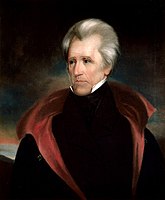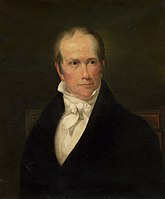The Anti-Masonic Party was the earliest third party in the United States. Formally a single-issue party, it strongly opposed Freemasonry in the United States. It was active from the late 1820s, especially in the Northeast, and later attempted to become a major party by expanding its platform to take positions on other issues. It declined quickly after 1832 as most members joined the new Whig Party; it disappeared after 1838.

The 1832 United States presidential election was the 12th quadrennial presidential election, held from Friday, November 2 to Wednesday, December 5, 1832. Incumbent president Andrew Jackson, candidate of the Democratic Party, defeated Henry Clay, candidate of the National Republican Party.

The 1836 United States presidential election was the 13th quadrennial presidential election, held from Thursday, November 3 to Wednesday, December 7, 1836. In the third consecutive election victory for the Democratic Party, incumbent Vice President Martin Van Buren defeated four candidates fielded by the nascent Whig Party.

The 1840 United States presidential election was the 14th quadrennial presidential election, held from Friday, October 30 to Wednesday, December 2, 1840. Economic recovery from the Panic of 1837 was incomplete, and Whig nominee William Henry Harrison defeated incumbent President Martin Van Buren of the Democratic Party. The election marked the first of two Whig victories in presidential elections, but was the only one where they won a majority of the popular vote. This was the third rematch in American history, which would not occur again until 1892.

The 1852 United States presidential election was the 17th quadrennial presidential election, held on Tuesday, November 2, 1852. Democrat Franklin Pierce defeated Whig nominee General Winfield Scott. A third party candidate from the Free Soil party, John P. Hale, also ran and came in third place, but got no electoral votes.

William Wirt was an American author and statesman who is credited with turning the position of United States Attorney General into one of influence. He was the longest-serving attorney general in U.S. history. He was also the Anti-Masonic nominee for president in the 1832 election.

The 1832 Democratic National Convention was held from May 21 to May 23, 1832, in Baltimore, Maryland. In the first presidential nominating convention ever held by the Democratic Party, incumbent President Andrew Jackson was nominated for a second term, while former Secretary of State Martin Van Buren was nominated for vice president.

The 55th New York State Legislature, consisting of the New York State Senate and the New York State Assembly, met from January 3 to July 2, 1832, during the fourth year of Enos T. Throop's governorship, in Albany.

The 56th New York State Legislature, consisting of the New York State Senate and the New York State Assembly, met from January 1 to April 30, 1833, during the first year of William L. Marcy's governorship, in Albany.

The 1832 United States presidential election in Pennsylvania took place between November 2 and December 5, 1832, as part of the 1832 United States presidential election. Voters chose 30 representatives, or electors to the electoral college, who voted for president and vice president.

The 1832 United States presidential election in Connecticut took place between November 2 and December 5, 1832, as part of the 1832 United States presidential election. Voters chose eight representatives, or electors to the Electoral College, who voted for president and vice president.

The 1832 United States presidential election in Illinois took place between November 2 and December 5, 1832, as part of the 1832 United States presidential election. Voters chose five representatives, or electors to the Electoral College, who voted for President and Vice President.

The 1832 United States presidential election in Maine took place between November 2 and December 5, 1832, as part of the 1832 United States presidential election. Voters chose ten representatives, or electors to the Electoral College, who voted for President and Vice President.

The 1832 United States presidential election in Massachusetts took place between November 2 and December 5, 1832, as part of the 1832 United States presidential election. Voters chose 14 representatives, or electors to the Electoral College, who voted for President and Vice President.

The 1832 United States presidential election in New Jersey took place between November 2 and December 5, 1832, as part of the 1832 United States presidential election. Voters chose eight representatives, or electors to the Electoral College, who voted for President and Vice President.

The 1832 United States presidential election in Ohio took place between November 2 and December 5, 1832, as part of the 1832 United States presidential election. Voters chose 21 representatives, or electors to the Electoral College, who voted for President and Vice President.

The 1832 United States presidential election in Vermont took place between November 2 and December 5, 1832, as part of the 1832 United States presidential election. Voters chose seven representatives, or electors to the Electoral College, who voted for President and Vice President.

The 1832 United States presidential election in Virginia took place between November 2 and December 5, 1832, as part of the 1832 United States presidential election. Voters chose 23 representatives, or electors to the Electoral College, who voted for President and Vice President.

The 1832 United States elections elected the members of the 23rd United States Congress. Taking place during the Second Party System and a political conflict over the re-authorization of the Second Bank of the United States, the elections were contested between Andrew Jackson's Democratic Party and opponents of Jackson, including the National Republicans. Though the Democrats retained the presidency and the House, they lost their Senate majority. The Anti-Masonic Party also fielded the first notable presidential candidacy from a third party.





















